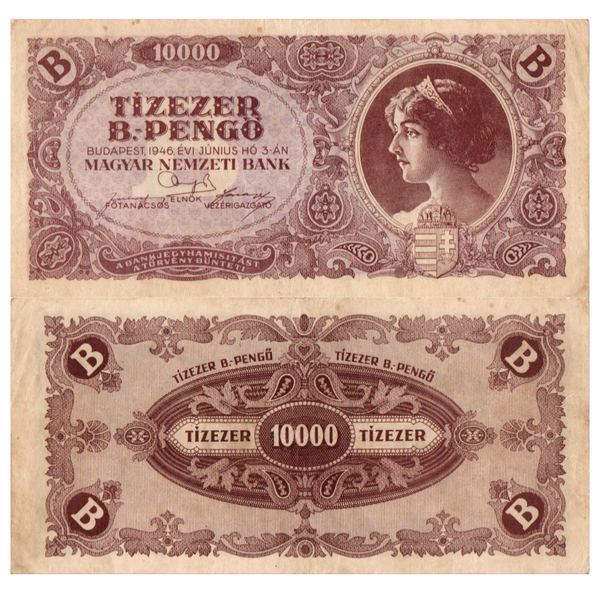-


1946 Hungary 100,000 B-Pengo PMG 64 CU P-133 Hyperinflation Note (100 Quadrillion) UNC
Inc. TaxInc. TaxRRP: Inc. Tax$319.00RRP:1946 Hungary 100,000 B-Pengo PMG 64 CU P-133 Hyperinflation Note (100 Quadrillion) UNC The 1946 Hungary 100,000 B-Pengő banknote, catalogued as P-133, is a prominent artifact from one of the most... -

 - 8%- 8%
- 8%- 8%1946 Hungary 1 Milliard B-Pengo Uncut Pair PMG 64 Choice UNC P-137b Ultra Rare
Inc. TaxInc. TaxRRP: Inc. Tax$8,500.00$9,200.00RRP:1946 Hungary 1 Milliard B-Pengo Uncut Pair PMG 64 Choice UNC | P-137b Hyperinflation This 1 Milliard (1 Billion) B-Pengo banknote from Hungary, 1946, represents one of the most extreme examples of... -

 - 25%- 25%
- 25%- 25%1946 HUNGARY 10 MILLION B-PENGO Banknote (10 Quintillion) P-135 Hyperinflation 1946 UNC
Inc. TaxInc. TaxRRP: Inc. Tax$389.00$517.00RRP:1946 Hungary 10 Million B-Pengo Banknote (10 Quintillion) P-135, Hyperinflation Era, UNC Description: Immerse yourself in the extraordinary world of historic currency with the 1946 Hungary 10 Million... -


1946 HUNGARY 100000 B-PENGO Banknote (100 Quadrillion) P-133 Hyperinflation 1946 RARE UNC
Inc. TaxInc. TaxRRP: Inc. Tax$229.00RRP:1946 HUNGARY 100000 B-PENGO Banknote (100 Quadrillion) P-133 Hyperinflation 1946 UNC Description: Introducing the remarkable 1946 Hungary 100000 B-Pengo Banknote, boasting an astonishing denomination... -

 - 10%- 10%
- 10%- 10%1946 Hungary 10,000 B-Pengo (10 quadrillion pengo) P-132 Hyperinflation USED ALMOST UNC Banknote
Inc. TaxInc. TaxRRP: Inc. Tax$179.00$199.00RRP:1946 Hungary 10,000 B-Pengo (10 quadrillion pengo) P-132 Hyperinflation USED Banknote The 1946 Hungarian 10,000 B.-Pengő banknote, cataloged as P-132, represents a staggering 10 quadrillion Pengő in...
Description
1946 Hungary 1 Milliard B-Pengo PMG 64 CU P-137 Exceptional Hyperinflation Banknote
Description:
The 1946 Hungary 1 Milliard B-Pengo banknote, cataloged as P-137 and graded PMG 64 CU (Choice Uncirculated), is a notable artifact from one of the most extreme hyperinflation periods in history. Representing a denomination of one milliard (one billion) B-Pengo, this note offers a glimpse into the economic turmoil faced by Hungary in the aftermath of World War II.
Design and Features:
-
Obverse: The front of the note features intricate patterns and detailed engravings typical of Hungarian banknotes from this era. The central design prominently displays the denomination "1 Milliard B-Pengo," surrounded by ornate borders and motifs that reflect the craftsmanship of the period. The use of bold and vibrant colors adds to the note's visual appeal.
-
Reverse: The reverse side continues the theme of elaborate designs and detailed engravings, often showcasing geometric patterns and national symbols. The denomination is again prominently featured to ensure clarity and recognition.
Security Features: During this period, security features were relatively basic compared to modern standards. The note relies on its intricate designs and detailed engravings to prevent counterfeiting.
Historical Significance: Issued in 1946, this banknote is a poignant reminder of the hyperinflation that devastated Hungary's economy following World War II. The 1 Milliard B-Pengo note reflects the extreme devaluation of currency and the government's efforts to stabilize the economy by issuing increasingly higher denominations. This period is marked by the issuance of the Adopengo as a temporary solution to manage the economic crisis.
Collector's Value: Graded PMG 64 CU (Choice Uncirculated), this banknote is in excellent condition, with sharp details, vibrant colors, and minimal signs of wear. The CU grade indicates that the note has been well-preserved, maintaining its original quality and appeal. Its historical significance and high preservation make it a valuable addition to collections focused on hyperinflationary currencies, European monetary history, or post-war economic crises.




